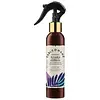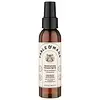What's inside
What's inside
 Key Ingredients
Key Ingredients

 Benefits
Benefits

 Concerns
Concerns

 Ingredients Side-by-side
Ingredients Side-by-side

Water
Skin ConditioningAloe Barbadensis Leaf Juice
Skin ConditioningPropanediol
SolventGlycerin
HumectantCetearyl Alcohol
EmollientPhyllanthus Emblica Fruit Extract
HumectantHydrolyzed Quinoa
Skin ConditioningHydrolyzed Adansonia Digitata Seed Extract
Hibiscus Sabdariffa Flower Extract
Skin ConditioningPhenoxyethanol
PreservativeBenzyl Alcohol
PerfumingCaprylic/Capric Triglyceride
MaskingParfum
MaskingCoconut Alkanes
EmollientCetyl Alcohol
EmollientOlealkonium Chloride
Behentrimonium Methosulfate
Behentrimonium Chloride
PreservativeVp/Va Copolymer
Xylitol
HumectantSalvia Hispanica Seed Extract
EmollientTrehalose
HumectantCaprylyl/Capryl Glucoside
CleansingCarthamus Tinctorius Seed Oil
MaskingEthyl Linoleate
EmollientIsopropyl Alcohol
SolventCoco-Caprylate/Caprate
EmollientEthyl Oleate
EmollientSorbitan Oleate
EmulsifyingPolyquaternium-37
Alcohol Denat.
AntimicrobialPolyquaternium-11
Stearamine Oxide
CleansingCaprylic/Capric Glycerides Polyglyceryl-10 Esters
EmollientGuar Hydroxypropyltrimonium Chloride
Skin ConditioningMyristyl Alcohol
EmollientStearyl Alcohol
EmollientSodium Phosphate
BufferingPolyquaternium-7
Caprylic Acid
CleansingOleamidopropyl Dimethylamine
Potassium Sorbate
PreservativeSodium Benzoate
MaskingAlcohol
AntimicrobialLaurtrimonium Chloride
EmulsifyingSodium Bisulfite
AntioxidantPentaerythrityl Tetra-Di-T-Butyl Hydroxyhydrocinnamate
AntioxidantTocopherol
AntioxidantBenzyl Salicylate
PerfumingLimonene
PerfumingHydroxycitronellal
PerfumingCitronellol
PerfumingWater, Aloe Barbadensis Leaf Juice, Propanediol, Glycerin, Cetearyl Alcohol, Phyllanthus Emblica Fruit Extract, Hydrolyzed Quinoa, Hydrolyzed Adansonia Digitata Seed Extract, Hibiscus Sabdariffa Flower Extract, Phenoxyethanol, Benzyl Alcohol, Caprylic/Capric Triglyceride, Parfum, Coconut Alkanes, Cetyl Alcohol, Olealkonium Chloride, Behentrimonium Methosulfate, Behentrimonium Chloride, Vp/Va Copolymer, Xylitol, Salvia Hispanica Seed Extract, Trehalose, Caprylyl/Capryl Glucoside, Carthamus Tinctorius Seed Oil, Ethyl Linoleate, Isopropyl Alcohol, Coco-Caprylate/Caprate, Ethyl Oleate, Sorbitan Oleate, Polyquaternium-37, Alcohol Denat., Polyquaternium-11, Stearamine Oxide, Caprylic/Capric Glycerides Polyglyceryl-10 Esters, Guar Hydroxypropyltrimonium Chloride, Myristyl Alcohol, Stearyl Alcohol, Sodium Phosphate, Polyquaternium-7, Caprylic Acid, Oleamidopropyl Dimethylamine, Potassium Sorbate, Sodium Benzoate, Alcohol, Laurtrimonium Chloride, Sodium Bisulfite, Pentaerythrityl Tetra-Di-T-Butyl Hydroxyhydrocinnamate, Tocopherol, Benzyl Salicylate, Limonene, Hydroxycitronellal, Citronellol
Water
Skin ConditioningPropanediol
SolventGlycerin
HumectantPyrus Malus Fruit Extract
Skin ConditioningSaccharomyces Cerevisiae Extract
Skin ConditioningTocopherol
AntioxidantBacopa Monnieri Extract
Skin ConditioningEclipta Prostrata Extract
Skin ConditioningAllium Cepa Bulb Extract
Skin ConditioningTrigonella Foenum-Graecum Seed Extract
PerfumingAloe Barbadensis Leaf Juice
Skin ConditioningHelianthus Annuus Seed Oil
EmollientTetrahexyldecyl Ascorbate
AntioxidantHelianthus Annuus Seed Extract
Skin ConditioningCentella Asiatica Extract
CleansingCurcuma Longa Root Extract
MaskingHydrolyzed Wheat Protein
Skin ConditioningHydrolyzed Wheat Starch
Skin ConditioningWheat Amino Acids
Skin ConditioningPhenoxyethanol
PreservativeCetearamidoethyldiethonium Succinoyl Hydrolyzed Pea Protein
CleansingPPG-26-Buteth-26
Skin ConditioningPEG-40
HumectantHydrogenated Castor Oil
EmollientPolyquaternium-4
Tetrasodium Glutamate Diacetate
Disodium EDTA
Ethylhexylglycerin
Skin ConditioningButylene Glycol
HumectantCitric Acid
BufferingPotassium Sorbate
PreservativeLeuconostoc/Radish Root Ferment Filtrate
AntimicrobialSodium Benzoate
MaskingParfum
MaskingBenzyl Salicylate
PerfumingLimonene
PerfumingHydroxycitronellal
PerfumingCitronellol
PerfumingWater, Propanediol, Glycerin, Pyrus Malus Fruit Extract, Saccharomyces Cerevisiae Extract, Tocopherol, Bacopa Monnieri Extract, Eclipta Prostrata Extract, Allium Cepa Bulb Extract, Trigonella Foenum-Graecum Seed Extract, Aloe Barbadensis Leaf Juice, Helianthus Annuus Seed Oil, Tetrahexyldecyl Ascorbate, Helianthus Annuus Seed Extract, Centella Asiatica Extract, Curcuma Longa Root Extract, Hydrolyzed Wheat Protein, Hydrolyzed Wheat Starch, Wheat Amino Acids, Phenoxyethanol, Cetearamidoethyldiethonium Succinoyl Hydrolyzed Pea Protein, PPG-26-Buteth-26, PEG-40, Hydrogenated Castor Oil, Polyquaternium-4, Tetrasodium Glutamate Diacetate, Disodium EDTA, Ethylhexylglycerin, Butylene Glycol, Citric Acid, Potassium Sorbate, Leuconostoc/Radish Root Ferment Filtrate, Sodium Benzoate, Parfum, Benzyl Salicylate, Limonene, Hydroxycitronellal, Citronellol
Ingredients Explained
These ingredients are found in both products.
Ingredients higher up in an ingredient list are typically present in a larger amount.
Aloe Barbadensis Leaf Juice comes from leaves of the aloe plant. Aloe Barbadensis Leaf Juice is best known for helping to soothe sunburns. It is also anti-inflammatory, moisturizing, antiseptic, and can help heal wounds.
Aloe is packed with good stuff including Vitamins A, C, and E. These vitamins are antioxidants, which help fight free-radicals and the damage they may cause. Free-radicals are molecules that may damage your skin cells, such as pollution.
Aloe Barbadensis Leaf Juice also contains sugars. These sugars come in the form of monosaccharides and polysaccharides, folic acid, and choline. These sugars are able to help bind moisture to skin.
It also contains minerals such as calcium, 12 anthraquinones, fatty acids, amino acids, and Vitamin B12.
Learn more about Aloe Barbadensis Leaf JuiceBenzyl Salicylate is a solvent and fragrance additive. It is an ester of benzyl alcohol and salicylic acid. This ingredient can be naturally found in some plants and plant extracts.
In fragrances, Benzyl Salicylate may be a solvent or a fragrance component. In synthetic musk scents, it is used as a solvent. For floral fragrances such as lilac and jasmine, it is used as a fragrance component. The natural scent of Benzyl Salicylate is described as "lightly-sweet, slightly balsamic".
While Benzyl Salicylate has been associated with contact dermatitis and allergies, emerging studies show it may not be caused by this ingredient alone.
However, this ingredient is often used with fragrances and other components that may cause allergies. It is still listed as a known allergen in the EU. We recommend speaking with a professional if you have concerns.
Another study from 2021 shows Benzyl Salicylate may have anti-inflammatory properties.
Learn more about Benzyl SalicylateCitronellol is used to add fragrance/parfum to a product. It is often derived from plants such as roses. In fact, it can be found in many essential oils including geranium, lavender, neroli, and more. The scent of Citronellol is often described as "fresh, grassy, and citrus-like".
Since the Citronellol molecule is already unstable, Citronellol becomes irritating on the skin when exposed to air.
Citronellol is a modified terpene. Terpenes are unsaturated hydrocarbons found in plants. They make up the primary part of essential oils.
Citronellol is not able to be absorbed into deeper layers of the skin. It has low permeability,
Citronellol is also a natural insect repellent.
Learn more about CitronellolGlycerin is already naturally found in your skin. It helps moisturize and protect your skin.
A study from 2016 found glycerin to be more effective as a humectant than AHAs and hyaluronic acid.
As a humectant, it helps the skin stay hydrated by pulling moisture to your skin. The low molecular weight of glycerin allows it to pull moisture into the deeper layers of your skin.
Hydrated skin improves your skin barrier; Your skin barrier helps protect against irritants and bacteria.
Glycerin has also been found to have antimicrobial and antiviral properties. Due to these properties, glycerin is often used in wound and burn treatments.
In cosmetics, glycerin is usually derived from plants such as soybean or palm. However, it can also be sourced from animals, such as tallow or animal fat.
This ingredient is organic, colorless, odorless, and non-toxic.
Glycerin is the name for this ingredient in American English. British English uses Glycerol/Glycerine.
Learn more about GlycerinHydroxycitronellal is a fragrance created from citronellal. The smell of hydroxycitronellal is often described as "citrus-like" or "melon-like".
Hydroxycitronellal is a known EU allergen and may cause irritation when applied to the skin.
Limonene is a fragrance that adds scent and taste to a formulation.
It's found in the peel oil of citrus fruits and other plants such as lavender and eucalyptus. The scent of limonene is generally described as "sweet citrus".
Limonene acts as an antioxidant, meaning it helps neutralize free radicals.
When exposed to air, oxidized limonene may sensitize the skin. Because of this, limonene is often avoided by people with sensitive skin.
The term 'fragrance' is not regulated in many countries. In many cases, it is up to the brand to define this term. For instance, many brands choose to label themselves as "fragrance-free" because they are not using synthetic fragrances. However, their products may still contain ingredients such as essential oils that are considered a fragrance.
Learn more about LimoneneParfum is a catch-all term for an ingredient or more that is used to give a scent to products.
Also called "fragrance", this ingredient can be a blend of hundreds of chemicals or plant oils. This means every product with "fragrance" or "parfum" in the ingredients list is a different mixture.
For instance, Habanolide is a proprietary trade name for a specific aroma chemical. When used as a fragrance ingredient in cosmetics, most aroma chemicals fall under the broad labeling category of “FRAGRANCE” or “PARFUM” according to EU and US regulations.
The term 'parfum' or 'fragrance' is not regulated in many countries. In many cases, it is up to the brand to define this term.
For instance, many brands choose to label themselves as "fragrance-free" because they are not using synthetic fragrances. However, their products may still contain ingredients such as essential oils that are considered a fragrance by INCI standards.
One example is Calendula flower extract. Calendula is an essential oil that still imparts a scent or 'fragrance'.
Depending on the blend, the ingredients in the mixture can cause allergies and sensitivities on the skin. Some ingredients that are known EU allergens include linalool and citronellol.
Parfum can also be used to mask or cover an unpleasant scent.
The bottom line is: not all fragrances/parfum/ingredients are created equally. If you are worried about fragrances, we recommend taking a closer look at an ingredient. And of course, we always recommend speaking with a professional.
Learn more about ParfumPhenoxyethanol is a preservative that has germicide, antimicrobial, and aromatic properties. Studies show that phenoxyethanol can prevent microbial growth. By itself, it has a scent that is similar to that of a rose.
It's often used in formulations along with Caprylyl Glycol to preserve the shelf life of products.
Potassium Sorbate is a preservative used to prevent yeast and mold in products. It is commonly found in both cosmetic and food products.
This ingredient comes from potassium salt derived from sorbic acid. Sorbic acid is a natural antibiotic and effective against fungus.
Both potassium sorbate and sorbic acid can be found in baked goods, cheeses, dried meats, dried fruit, ice cream, pickles, wine, yogurt, and more.
You'll often find this ingredient used with other preservatives.
Learn more about Potassium SorbatePropanediol is an all-star ingredient. It softens, hydrates, and smooths the skin.
It’s often used to:
Propanediol is not likely to cause sensitivity and considered safe to use. It is derived from corn or petroleum with a clear color and no scent.
Learn more about PropanediolSodium Benzoate is a preservative. It's used in both cosmetic and food products to inhibit the growth of mold and bacteria. It is typically produced synthetically.
Both the US FDA and EU Health Committee have approved the use of sodium benzoate. In the US, levels of 0.1% (of the total product) are allowed.
Sodium benzoate works as a preservative by inhibiting the growth of bacteria inside of cells. It prevents the cell from fermenting a type of sugar using an enzyme called phosphofructokinase.
It is the salt of benzoic acid. Foods containing sodium benzoate include soda, salad dressings, condiments, fruit juices, wines, and snack foods.
Studies for using ascorbic acid and sodium benzoate in cosmetics are lacking, especially in skincare routines with multiple steps.
We always recommend speaking with a professional, such as a dermatologist, if you have any concerns.
Learn more about Sodium BenzoateTocopherol (also known as Vitamin E) is a common antioxidant used to help protect the skin from free-radicals and strengthen the skin barrier. It's also fat soluble - this means our skin is great at absorbing it.
Vitamin E also helps keep your natural skin lipids healthy. Your lipid skin barrier naturally consists of lipids, ceramides, and fatty acids. Vitamin E offers extra protection for your skin’s lipid barrier, keeping your skin healthy and nourished.
Another benefit is a bit of UV protection. Vitamin E helps reduce the damage caused by UVB rays. (It should not replace your sunscreen). Combining it with Vitamin C can decrease sunburned cells and hyperpigmentation after UV exposure.
You might have noticed Vitamin E + C often paired together. This is because it is great at stabilizing Vitamin C. Using the two together helps increase the effectiveness of both ingredients.
There are often claims that Vitamin E can reduce/prevent scarring, but these claims haven't been confirmed by scientific research.
Learn more about TocopherolWater. It's the most common cosmetic ingredient of all. You'll usually see it at the top of ingredient lists, meaning that it makes up the largest part of the product.
So why is it so popular? Water most often acts as a solvent - this means that it helps dissolve other ingredients into the formulation.
You'll also recognize water as that liquid we all need to stay alive. If you see this, drink a glass of water. Stay hydrated!
Learn more about Water